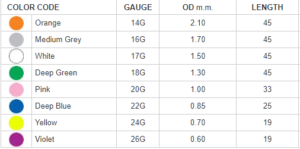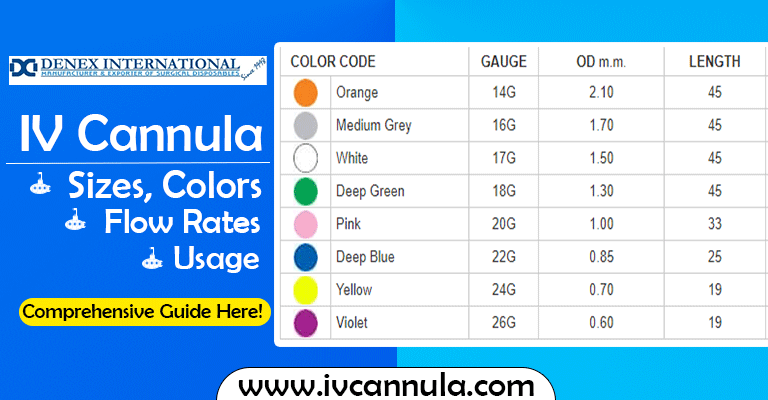In medical care, Intravenous (IV) cannulas play a crucial role in ensuring effective and efficient delivery of fluids and medications to patients. Denex International, a leading IV Cannula manufacturer, understands the significance of choosing the right IV cannula for various medical applications. This comprehensive guide will delve into the intricacies of IV cannula sizes, colors, flow rates, and usage, providing valuable insights for healthcare professionals and enthusiasts alike.
IV Cannula
An Intravenous (IV) cannula, often called an IV line or catheter, is a medical device used to administer fluids, medications, blood, or other treatments directly into a patient’s bloodstream. It is a crucial tool in healthcare settings, allowing for the efficient delivery of substances that need to reach the circulatory system quickly. Let’s delve into the components, insertion process, and common uses of IV cannulas.
Components of an IV Cannula:
Cannula Tubing: The main part of the IV cannula is a flexible tube, usually made of materials like polyurethane or Teflon, which is biocompatible and minimizes the risk of adverse reactions.

Needle or Stylet: The needle or stylet is a sharp, pointed component at the front end of the cannula, facilitating the initial puncture through the patient’s skin and into a vein.

Wings: The wings are flat, wing-like structures on either side of the cannula that allow for easy handling during insertion.

Hub: The hub is the cannula’s back end, connecting to IV tubing or other devices. It often contains a port for securing the IV line in place.

IV Cannula Sizes:
IV cannulas come in different sizes, each catering to specific medical needs. The length of an IV cannula is denoted by the gauge, with lower gauge numbers indicating larger cannulas. Commonly used sizes include 14G, 16G, 17G,18G, 20G, 22G,24G and 26G. Larger gauges allow for a faster flow of fluids, making them suitable for situations where rapid fluid administration is required, such as in trauma cases.

IV Cannula Colors and IV Cannula Flow Rates:
Colors associated with IV cannulas serve as a quick visual indicator for healthcare providers, aiding in easily identifying the cannula size. Denex International follows industry standards, assigning specific colors to different gauge sizes. For instance, orange is typically associated with 14G, Medium Gray with 16G,White with 17G, Deep Green with 18G, Pink with 20G, Deep Blue with 22G, Yellow with 24G and Violet with 26 G. This color-coding system enhances workflow efficiency and reduces the risk of errors in clinical settings.

Flow rates are a critical consideration when selecting an IV cannula. The gauge size directly influences the flow rate, with larger gauges allowing for a more rapid infusion of fluids. Healthcare professionals must carefully assess the patient’s condition and the intended purpose of the IV administration to choose the appropriate cannula size and flow rate. Denex International’s range of IV cannulas ensures that healthcare providers have versatile options to meet diverse patient needs.

Insertion Process of IV Cannula:
Preparation: Before inserting the IV cannula, healthcare providers clean the insertion site with an antiseptic solution to reduce the risk of infection.
Vein Selection: The healthcare professional selects a suitable vein for insertion, often choosing the back of the hand, forearm, or antecubital fossa.
Puncture: The needle or stylet is inserted through the skin and into the vein. Once the hand is in place, blood may flow back into the tubing, confirming proper placement.
Advancement: After confirmation, the needle is partially withdrawn, leaving the flexible tubing (cannula) in the vein. The hand or style is then fully removed.
Securement: The wings of the cannula are used to secure it with tape or an adhesive dressing.
Read Also: How to Insert IV Cannula with Ease
Common Uses of IV Cannulas:
Fluid Administration: IV cannulas are frequently used to administer fluids, such as saline or electrolyte solutions, to maintain hydration or correct imbalances.
Medication Administration: Medications, including antibiotics, pain relievers, and chemotherapy drugs, can be administered through IV cannulas for quick and efficient delivery.
Blood Transfusions: In cases of severe blood loss or certain medical conditions, IV cannulas are employed to transfuse blood and blood products.
Diagnostic Tests: Some diagnostic tests, such as contrast imaging studies, require the injection of substances directly into the bloodstream using IV cannulas.
Choosing the Right IV Cannula for Different Scenarios:
Emergency Situations (14G): In emergencies where rapid fluid resuscitation is paramount, a larger gauge IV cannula, such as 14G, is recommended.
General Hospital Use (18G and 20G): For routine hospital scenarios, where a balance of fluid delivery and patient comfort is essential, healthcare providers often opt for 18G or 20G cannulas.
Pediatric and Fragile Patients (22G): In pediatric cases or with fragile patients, a smaller gauge IV cannula, such as 22G, may be chosen to minimize discomfort and the risk of complications.
Read Also: Choosing the Right IV Cannula Size for Blood Transfusion
Conclusion:
Denex International stands at the forefront of providing high-quality IV cannulas designed to meet the diverse needs of the medical community. By understanding the nuances of IV cannula sizes, colors, flow rates, and usage, healthcare professionals can make informed decisions to optimize patient care. As a trusted IV cannula manufacturer, Denex International remains committed to advancing healthcare solutions, prioritizing patient well-being and medical efficacy.







